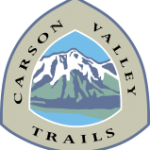Short History of the Carson Valley Trails Association
December 2025
Early Years
1994 – With access to local public lands diminishing because of changing landowners and new housing developments, a group of local citizens forms the Carson Valley Community Access (CVCA) to maintain existing or establish new public access to adjacent public lands.
1995-2000 – In a cooperative effort with stakeholders including the U.S. Forest Service (USFS), Bureau of Land Management (BLM), Douglas County and private landowners, CVCA begins planning for access and trail opportunities in and around the Carson Valley for hiking, biking and equestrian use.
1996 – CVCA files articles of incorporation and becomes a non-profit organization.
2000 – CVCA changes its name to the Carson Valley Trails Association (CVTA).
2002-2003 – CVTA and other stakeholders work with Douglas County to create the Douglas County Comprehensive Trails Plan. This plan is part of the County’s Master Plan and provides a general framework for trails planning within the County. This plan was updated in 2023-2024.
Fay-Luther/Jobs Peak Ranch Trail System
1997 – An environmental assessment jointly prepared between the USFS and BLM is signed for the Fay-Luther Trailhead for non-motorized recreation access. CVCA partners with The American Land Conservancy to purchase 2.35 acres of private property between Foothill Road and the BLM in Alpine County from a willing seller to develop the Fay-Luther Trailhead. The trailhead is then deeded over to the U.S. Forest Service. The trailhead is developed in 2000 and opens for public use.
2005 – Public use of the Fay-Luther Trailhead continues to grow steadily. CVTA forms a trail clean-up volunteer crew to help clean up dog waste several times per week. CVTA provides dog bags and waste buckets for the public to use and continues today.
2006 – The BLM completes an Environmental Assessment for the Fay-Luther Trail System. The Jobs Peak Ranch Trailhead is built, and CVTA constructs the Jobs Peak Ranch Trail on a Douglas County easement on Jobs Peak Ranch property. This is the first constructed and formally recognized trail in Carson Valley.
2007 – CVTA constructs and opens the Interpretive Loop and Bitter Cherry Trail.
2008 – CVTA connects the Jobs Peak Ranch Trail to the Fay-Luther Trailhead. This entire trail between the two trailheads is renamed the Fay-Luther/Jobs Peak Ranch Trail.
2008 – CVTA constructs and opens the Grand View Loop, Valley View Loop and Jeffrey Pine Trail.
2009 – CVTA installs trail signs and trail maps throughout the Fay-Luther/Jobs Peak Ranch Trail System. This 9-mile trail system becomes the first formally recognized trail system within the Carson Valley.
2010 – CVTA installs interpretive signs along the Interpretive Loop of the trail system, providing a learning opportunity about the areas unique human and natural history.
2016 – The BLM approves an environmental assessment for CVTA to realign a section of trail on the Grand View, Interpretive and Lonesome Trails. These realignments are then built and opened.
2016 – CVTA proposes the Appaloosa Trail and various realignments.
2023 – CVTA completes most realignment improvements and adds the Appaloosa Trail. The trail system is now just over 11 miles.
Bently Heritage Trail
2014-2019 – Boardwalks are constructed over wet/muddy trail sections in partnership with multiple Eagle Scout projects.
2016 – Bently Ranch renames the trail to the Bently Heritage Trail. The dirt access road is graveled to improve vehicle access, and trailhead directional signs are installed along Heybourne Road and Stephanie Lane.
Genoa Trail System
2011 – Approximately 17 of the 20 proposed miles are approved for construction through a USFS Environmental Assessment. The Eagle Ridge Trailhead and most of the trail system is built during 2011.
2012 – The trail system is completed and opens in May. This becomes the third formally recognized trail system within Carson Valley.
2013-2017 – CVTA completes most trail finishing projects including construction of wooden and rock causeways, retaining walls, a bridge, rock crossings, safety railings, and realignment improvements.
River Fork Ranch Trail System
2008 – CVTA proposes the 32-mile Clear Creek Trail System connecting the Tahoe Rim Trail with Highway 395, and the associated Clear Creek Connector, Jacks Valley Loop and James Lee Loops.
2011 – Approximately 10 of the 32 miles are approved for construction by the USFS.
2013-2014 – Half the Clear Creek Trail, and the Clear Creek Connector are constructed and open in April. This becomes the fifth formally recognized trail system within Carson Valley.
2017-2018 – The upper 6.5 miles of the Clear Creek Trail is approved in 2017 by the USFS. This portion of the trail is built in 2018 and opened in August.
2020-2022 – The lower portion of the Clear Creek Trail, Jacks Valley Loop and James Lee Loops are analyzed a second time. The lower Clear Creek Trail and Jacks Valley Loop sections are approved in 2021 and constructed in 2022.
2020-2023 – The James Lee Loops are analyzed a third time, approved in 2022 and constructed in 2023. The entire Clear Creek Trail System is now 30 miles in length.
Pinyon Trail
2008 – CVTA proposes the 30-mile Pinyon Trail on the southeast side of Carson Valley.
2013 – The BLM approves construction of 4 miles of trail.
2014-2015 – The Pinyon Trail and Pinyon Trailhead are built, and the trail opens March, 2015. This becomes the sixth formally recognized trail system within Carson Valley.
Juniper Trail System
2008 – CVTA proposes the 10-mile Juniper Trail System on the northeast side of Carson Valley.
2013 – The BLM approves construction of the trail.
2017 – Upon start of construction, the BLM halts the project due to potential retention basins being constructed on the project.
2021-2023 – No detention basins are determined to affect the project and the project awaits a reapproval to begin construction.
